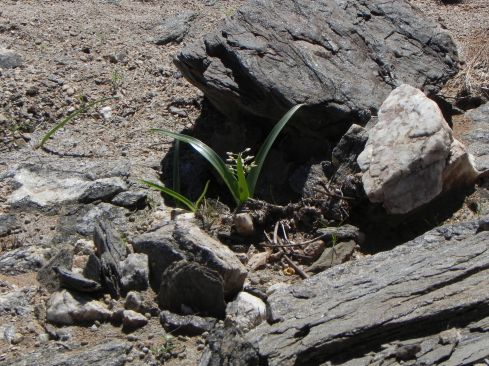I have to confess to a guilty secret: there is a pleasure-inducing activity I have been indulging in for a week at a time these past three years.
And not alone….
This consists of going to the Gobabeb Research & Training Centre in the Namib Desert as part of an international “scientific expedition” aimed at investigating microbial soil biodiversity in the sandy and stony desert round Gobabeb. These were started by Professor Don Cowan when he was at the University of the Western Cape, and have fortunately continued now that he has moved to a new Institute at the University of Pretoria.

Typical quartz-associated hypolith
I put the scientific expedition in quotes because anything that much fun shouldn’t be called scientific, but hey, it’s already resulted in one major paper on hypolith-associated viruses that I’m a minor author on, another co-authored opinion piece in the South African Journal of Science on biodiversity assessment that got the cover, as well as me being invited to be part of the Gobabeb station’s Microbiology & Fungi research “Theme Group“.
Moreover, I am now on the Board of the Institute for Microbial Biotechnology and Metagenomics at UWC on the strength of working with Marla Trindade and Lonnie van Zyl and others on scraping bits of green stuff off rocks and then watching them ultrafilter washings of it – so I suppose that we really did do some science, even if it was sinfully enjoyable. In any case, something that happened last year took me back to my roots – as well as possibly getting me some street (or gully) cred with the biodiversity crowd.

The heavily gullied area near Homeb
Basically, there we were in the Welwitschia-rich gullies near Homeb, 11 km from Gobabeb, visiting said plants. There had been some rain 3 weeks previously, apparently, and there was an amazing eruption of foliage from some kind of bulb, every plant the same age and every one frantically flowering for all they were worth. This alone was noteworthy, as the gullies were completely devoid of any trace of such plants the previous year. As we were wandering about, looking at Welwitschias, one Olivier Zablocki from the Univ Pretoria team – who had just done a MSc in plant virology with Gerhard Pietersen at UP – said something along the lines of “I wonder if there are any viruses infecting these plants?”.

Welwitschia down in the gully
“What, like that one?” I said, having just fortuitously noticed a plant with tell-tale streaks on its leaves. Of course, I seem to have lost my photos – temporarily, I hope! – after a Mac Mini OSX update disaster, but Olivier was kind enough to provide the necessary:

Streaky Albuca. Note how quickly the fruit has formed, just a couple of days after flowering.
This sparked a flurry of activity, with people being called to observe the plant, and going out and looking for more.
Which were not found: not one other plant, of the hundreds we saw there and nearer Homeb, had any streaks at all. What is more, they were growing all up and down some of the more inhospitable gravelly and rocky slopes I have ever seen, meaning they had to be seriously drought-tolerant, given the unlikelihood of them ever being exposed to much water. This meant they must be ephemeral, or putting out foliage and flowers only after rain – and I have never seen anything flower as fast; three days later they were already fruiting.

Albuca growing in the gully
We made the collective decision that this was sufficiently scientifically interesting to warrant its collection, and the plant was carefully dug up – with difficulty; the onion-like bulb was deep and seriously embedded among rocks – and carefully transported back to Gobabeb, hopefully for identification and then packaging to be taken back to Pretoria.

Healthy Albuca growing in gravel
And yes, we did have a permit!
Meaning the foliage could go back to Pretoria, and there be subjected by Olivier to electron microscopy, and then RNA isolation and cDNA synthesis. And lo, it came to pass – that a new potyvirus was discovered. Kudos, Olivier and the Cowan lab! The ms is submitted, and we wait only for…well, acceptance would be nice, but the proof is in the sequence. And the pictures – murky EMs done by Olivier from precious tissue extracts, to boot.

Transmission EM from diseased Albuca extract
And it took an old plant virologist to find it. Life in the greying dog yet!
…and now it’s published – as a Disease Note in Plant Disease. Thanks Evelien!






